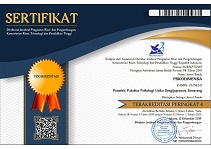Keterampilan Menolak secara Asertif pada Kelompok Remaja yang Mengalami Tekanan Negatif Teman Sebaya: Pelatihan Daring selama Pandemi COVID-19
Abstract
Abstrak: Pertemanan pada tahapan usia remaja awal sering kali didominasi oleh tekanan negatif dari teman sebaya yang dapat meningkatkan adanya kemungkinan permasalahan adaptasi dan perilaku di masa depan. Saat pandemi COVID-19 terjadi dan remaja tidak perlu bertemu secara langsung, tekanan sebaya ini masih terus terjadi. Penelitian ini adalah sebuah pelatihan kelompok berbasis daring yang bertujuan untuk meningkatkan keterampilan menolak secara asertif pada remaja yang menghadapi tekanan negatif teman sebaya. Enam siswa (usia 12-13 tahun) menjadi partisipan penelitian ini. Mereka mengikuti lima sesi pelatihan kelompok online yang masing-masing berdurasi 60 menit. Penelitian ini merupakan penelitian quasi-eksperimen, dan hasil skor dianalisis menggunakan Friedman’s test. Sebagai hasilnya, keterampilan menolak dan berperilaku asertif meningkat setelah adanya pelatihan ini. Partisipan juga menujukkan rasa lebih percaya diri untuk mengaplikasikan keterampilan menolak asertif di kehidupan sehari-hari. Oleh karena itu, kami menyarankan penggunaan pelatihan ini untuk meningkatkan keterampilan menolak asertif.
Kata kunci: keterampilan menolak asertif, tekanan negatif teman sebaya, pelatihan kelompok daring
Abstract: Friendships in early adolescent are usually dominated by negative peer pressure. This conceivably develop adjustment and behavioral problems in the future. This peer pressure is still happening even when adolescents do not meet regularly due to the COVID-19 pandemic. This research was an online group training aimed to enhance assertive refusal skills in adolescents exposed to negative peer pressure. Six students in their seventh grade (age 12-13) took part in this research. They participated in a five session of 60-minutes online group training. This research was a quasi-experimental research, and the scores of refusal skills and assertive skills were analyzed using Friedman’s test. As a result, participants’ refusal and assertive skill increase after participating in this training. Participants also reported that they felt more confident to apply assertive refusal skills in their daily lives. Thus, this we suggested that this online intervention could be used to increase adolescents’ assertive refusal skills.
Keywords: assertive refusal skill, negative peer pressure, online group training
Keywords
Full Text:
PDFReferences
Bishop, S. (2013). Develop your assertiveness. London: Kogan Page Publishers.
Bronson, M. (2015). Florida Health. New York: McGraw Hill Education.
Brown, B.B., Clasen, D.R., & Eicher, S.A. (1986). Perceptions of peer pressure, peer conformity dispositions, and self-reported behavior among adolescents. Developmental Psychology, 22, 521-530.
Clasen, D. R., & Brown, B.B. (1985). The multidimensionality of peer pressure in adolescence. Journal of Youth and Adolescence, 14, 451-468.
Crosnoe, R. (2000). Friendships in childhood and adolescence: The life course and new directions. Social psychology quarterly, 63(4), 377-391.
Curtis, A. C. (2015). Defining adolescence. Journal of adolescent and family health, 7(2), 2.
Daly, P. (1996). The effect of single-sex and coeducational secondary schooling on girls’ achievement. Research Papers in Education, 11(3), 289-306.
Dickson, S. (2016). Utah’s Safe and Drug-Free Schools and Communities: PK-12 Prevention Program. Utah: Utah State Office of Education.
Dishion, T. J., & Stormshak, E. A. (2007). Intervening in children's lives: An ecological, family-centered approach to mental health care. American Psychological Association.
Dury, K., Bukowski, W.M., Velasquez, A.M., & Stella-Lopez, L. (2012). Victimization and gender identity in single-sex and mixed-sex schools: Examining contextual variations in pressure to conform to gender norms. Sex Roles, 69, 442-454.
Economy, M.M. (1979). Assertiveness training a study of its effects with female adolescent. Thesis. Faculty of Psychology California State University.
Gikonyo, R.W., & Njagi, K. (2016). The influence of demographic factors on peer pressure among secondary school adolescent in Nyahuru Laikipa County, Research on Humanities and Social Science, 6(22), 87-91.
Gidron, Y. (2013). Group therapy/intervention. In M.D. Gellman, J.R. Turner. Encyclopedia of Behavioral Medicine (Eds.). New York: Springer.
Gordon, V.H., & Guerriero, J.R. (2012). Do single-sex classes and/or schools better address the needs of elementary and/or secondary students?. In A.G. Osborne., C.J. Russo., & G.M. Cattaro. (Eds). Alternative Schooling and School Choice. California: SAGE Publications.
Hall, K.R., Rushing, J.L., Khursid, A. (2009) Using the solving problems together psychoeducation group counseling model as an intervention for negative peer pressure. The Journal for Specialists in Group Works, 36(2), 97-110.
Hamonangan, J. (2020). “Melanggar PSBB, Remaja ini Dikenakan Sanksi Bersihkan Sampah di Pulau Tidung (20 Mei 2020).” www.tribunnews.com, Diakses pada 30 Juni 2020 dari https://wartakota.tribunnews.com/2020/05/20/melanggar-psbb-remaja-ini-dikenakan-sanksi-bersihkan-sampah-di-pulau-tidung?page=4
Kaplan, R. M. & Saccuzzo, D.P. (2009). Psychological testing: Principles, applications, and issues. Belmont, CA: Wadsworth Cengage Learning.
Lebedina-Manzoni, M., Lotar, M., & Ricijas, N. (2011). Peer Pressure in Adolescence Boundaries and Possibilities. Saarbrucken, LAP LAMBERT Academic Publishing.
Lebedina-Manzoni, M., & Ricijas, N. (2013). Characteristics of youth regarding susceptibility to peer pressure. Kriminologija i socijalna integracija, 21.
Mael, F. A. (1998). Single-Sex and Coeducational Schooling: Relationships to Socioemotional and Academic Development. Review of Educational, 68(2), 101-129.
Martin, J.N., & Rohrlich, B. (1991). The relationship between study-abroad student expectations and selected student characteristics. Journal of College Student Development, 32(1), 39-46.
Martina, L., & Zeljka, K. (2013). Susceptibility to peer pressure and attachment to friends. Psihologija, 46(2), 112-126.
Nunnally & Bernstein, I.H. (1994). Psychometric Theory 3rd ed. New York: McGraw Hill.
Rahel (2014). Asosiasi antara Tekanan Teman Sebaya, Emosi Malu, dan Emosi Bersalah pada Remaja. Skripsi. Fakultas Psikologi Universitas Indonesia.
Sekretariat Kabinet Republik Indonesia. (2020, Maret 15). Perkembangan Terkini Penanganan Pandemi Virus Korona, 15 Maret 2020, di Istana Kepresidenan Bogor, Provinsi Jawa Barat. Diakses pada 30 Juni 2020 dari https://setkab.go.id/ perkembangan-terkini-penanganan-pandemi-virus-korona-15-maret-2020-di-istana- kepresidenan-bogor-provinsi-jawa-barat/
Zulkaida, A. (2004). Pelatihan Asertif untuk Meningkatkan Perilaku Asertif Pada Mahasiswa (Pendekatan Kognitif-Tingkah Laku). Skripsi. Fakultas Psikologi Universitas Indonesia
DOI: https://doi.org/10.24167/psidim.v20i1.2850
Print ISSN : 1411-6073 | online ISSN : 2579-6321 View My Stats

This work is licensed under a Creative Commons Attribution 4.0 International License.




















